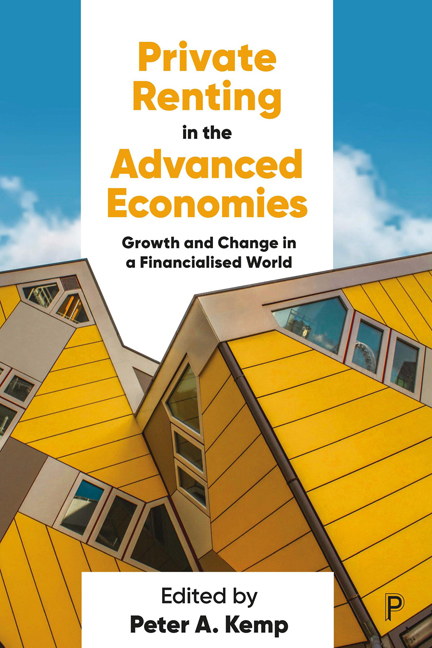Book contents
- Frontmatter
- Contents
- List of figures, tables and boxes
- List of abbreviations
- Notes on contributors
- Preface
- 1 New trajectories in private rental housing
- 2 Growth and change: private renting in Australia in the 21st century
- 3 Rental housing dynamics and their affordability impact in the United States
- 4 The Irish rental sector and the post-homeownership society: issues and challenges
- 5 Private renting in England: growth, change and contestation
- 6 Private renting in the Netherlands: set to grow?
- 7 Suppressive regulation and lower political esteem: private renting in Germany at the beginning of decline
- 8 Private renting in Denmark: foreign investors in the crosshairs
- 9 Norway: booming housing market and increasing small-scale landlordism
- 10 Private rented markets in Spain and housing affordability
- 11 The short-run impact of COVID-19 on the private rented sector
- 12 Change and continuity in private rental housing
- Index
2 - Growth and change: private renting in Australia in the 21st century
Published online by Cambridge University Press: 03 April 2024
- Frontmatter
- Contents
- List of figures, tables and boxes
- List of abbreviations
- Notes on contributors
- Preface
- 1 New trajectories in private rental housing
- 2 Growth and change: private renting in Australia in the 21st century
- 3 Rental housing dynamics and their affordability impact in the United States
- 4 The Irish rental sector and the post-homeownership society: issues and challenges
- 5 Private renting in England: growth, change and contestation
- 6 Private renting in the Netherlands: set to grow?
- 7 Suppressive regulation and lower political esteem: private renting in Germany at the beginning of decline
- 8 Private renting in Denmark: foreign investors in the crosshairs
- 9 Norway: booming housing market and increasing small-scale landlordism
- 10 Private rented markets in Spain and housing affordability
- 11 The short-run impact of COVID-19 on the private rented sector
- 12 Change and continuity in private rental housing
- Index
Summary
Introduction
An important feature of the Australian housing system in the 2000s has been the sustained growth of private renting. This development denotes a change in what has long been characterised as a classic homeownership society. In the decades after the Second World War, private renting declined as homeownership increased to the early 1970s, followed by a period of relative stability in the housing system until the 1990s. From that time, private renting began to increase again as homeownership rates fell modestly (Burke et al, 2014). In the 2000s the private rental sector began to grow more strongly, with changes in the profile of tenants, landlord investment and more professional management of properties.
Definitions of private renting vary between countries (Haffner et al, 2010). In Australia, private renting refers to households who live in private properties who pay rent to either a real estate agent or a private landlord who does not live with the tenant. This definition excludes households paying rent to residential park operators and employers (government and other) and social landlords (public and not-for-profit landlords). Rents are set according to the market and vary between accommodation types/ sizes and by area and lettings are based on ability to pay market rent not administrative criteria. Private rental housing is not a distinct stock that has been purpose built and managed for rental; properties move between ownership and private rental, either on sale or simply change of use (Hulse and Yates, 2017). For this reason, rented accommodation is not usually let furnished nor do rents usually include utility costs as is the case in some other countries. There are other rental niches with purpose-built accommodation which are let to specific groups, often furnished, and including utilities, including short-term lets like Airbnb, rooming houses and purpose-built student accommodation (Pawson et al, 2020: 181). This chapter examines growth and change in the private rental sector in the 2000s.
Changes in the size and role of the Australian private rental sector
More than a quarter of all Australian households rent privately, up from just over one in five at the start of the 21st century.
- Type
- Chapter
- Information
- Private Renting in the Advanced EconomiesGrowth and Change in a Financialised World, pp. 18 - 41Publisher: Bristol University PressPrint publication year: 2023



